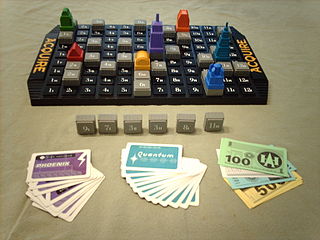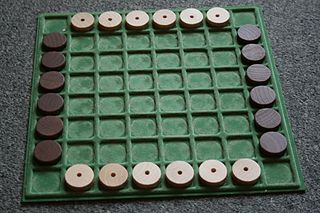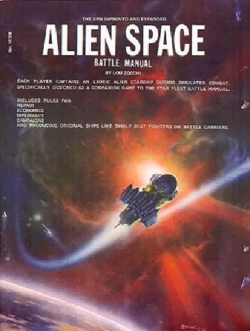Related Research Articles

Acquire is a board game published by 3M in 1964 that involves multi-player mergers and acquisitions. It was one of the most popular games in the 3M Bookshelf games series published in the 1960s, and the only one still published in the United States.

Checkers, also known as draughts, is a group of strategy board games for two players which involve forward movements of uniform game pieces and mandatory captures by jumping over opponent pieces. Checkers is developed from alquerque. The term "checkers" derives from the checkered board which the game is played on, whereas "draughts" derives from the verb "to draw" or "to move".
Sid Sackson was an American board game designer and collector, best known as the creator of the business game Acquire.

Epaminondas is a strategy board game invented by Robert Abbott in 1975. The game is named after the Theban general Epaminondas, known for the use of phalanx strategy in combat. The concept of the phalanx is integral to the game.
A Gamut of Games is an innovative book of games written by Sid Sackson and first published in 1969. It contains rules for a large number of paper and pencil, card, and board games. Many of the games in the book had never before been published. It is considered by many hobbyist gamers to be an essential text for anyone interested in abstract strategy games, and a number of the rules were later expanded into full-fledged published board games.
Three Musketeers is an abstract strategy board game by Haar Hoolim. It was published in Sid Sackson's A Gamut of Games (2011). Like the traditional game fox and geese, it uses the principle of unequal forces; the two players neither use the same types of pieces nor the same rules, and their victory conditions are different.
Crossings is a two-player abstract strategy board game invented by Robert Abbott. The rules were published in Sid Sackson's A Gamut of Games. Crossings was the precursor to Epaminondas, which uses a larger board and expanded rules.

Fields of Action is an abstract strategy board game for two players.

Focus is an abstract strategy board game, designed by Sid Sackson and first published in 1963 by Kosmos. The game has been re-published many times since, sometimes under the titles Domination or Dominio. Focus won the 1981 Spiel des Jahres and Essen Feather awards. The game appears in Sackson's A Gamut of Games in the section New Battles on an Old Battlefield.

Surakarta is an Indonesian abstract strategy board game for two players, named after Surakarta, Central Java. The game features an unusual method of capture which is "possibly unique" and "not known to exist in any other recorded board game". Little is known about its history.
Patterns II is a pencil and paper game developed by Sid Sackson for 3 or more players. It emphasizes the use of inductive logic and scientific analysis to discover a hidden pattern of symbols within a matrix of grid spaces.

Blue and Gray is a strategy board game for two players invented by Henry Busch and Arthur Jaeger in 1903. They obtained a patent for the game, but may never have published it. The name Blue and Gray "refers to the uniforms of the South and the North in the Civil War and in the original game the playing pieces of the contestants were of those colors." Blue and Gray is a variant of checkers.
Brax is a two-player abstract strategy board game. It was invented in 1889 in America by Frederic B. Denham of New York City. The board design is unique. The players move their pieces along paths on the square board; each path is one of two colors. A piece can move one or two spaces in a turn depending upon whether it matches the color of the path. Players attempt to capture each other's pieces.

Lines of Action is an abstract strategy board game for two players invented by Claude Soucie. The objective is to connect all of one's pieces into a single group. The game was recommended by the Spiel des Jahres in 1988.

Onyx is a two-player abstract strategy board game invented by Larry Back in 1995. The game features a rule for performing captures, making Onyx unique among connection games.

Diamond is a two-player abstract strategy board game invented by Larry Back. The invention was inspired by the game Kensington, which uses a similar board pattern and game objective. Rules for Diamond were conceived in 1985 and finalized in 1994. Diamond introduces a new board geometry and neutral pieces, with the aim of enhancing the game dynamic and lowering the potential for draws.

Alien Space is a science fiction board wargame published by Gamescience in 1973 that simulates space combat as seen in the Star Trek television show.
The Generals, or The Generals Electronic Strategy Game, is an electronic abstract strategy game published in 1980 by Ideal Toy Company. It implements the gameplay of the 1970 game Game of the Generals, in which two players contest control of spaces on a game board by moving game pieces with ranks hidden to their opponent and challenging opposing pieces; the results of challenges are determined by the hierarchy of ranks of those pieces, in a manner similar to Stratego, and decided by an electronic arbiter.
Domain is a tile-based abstract strategy game first published throughout Europe in 1982. Players place multicoloured polymino tiles on a game board and flip any of their opponent's pieces adjacent to them in order to have the most squares covered by their colour at the end of the game.
Le Trioker is an corner-matching puzzle game played using 25 equilateral triangle-shaped tiles. Each corner is marked with zero, one, two, or three dots and newly placed pieces must match the values on pieces already placed on the game board, similar to the gameplay of the earlier Triominoes.
References
- 1 2 "Tri-Nim Game". National Museum of American History. Retrieved 2023-03-28.
- 1 2 3 Wells, David (October 1975). "Games View". Games & Puzzles (41). A H C Publications: 19 – via Internet Archive.
- ↑ Hounshell, Paul B.; Trollinger, Ira R. (1977). Games for the Science Classroom. Washington: National Science Teaching Association. p. 229. ISBN 9780873550062 – via Internet Archive.
- ↑ Kaye, Marvin (January 1980). "Games". Galileo (16): 24 – via Internet Archive.
- ↑ Sackson, Sid (1982). A Gamut of Games (2nd ed.). New York: Pantheon Books. p. 221. ISBN 0-394-71115-7 – via Internet Archive.